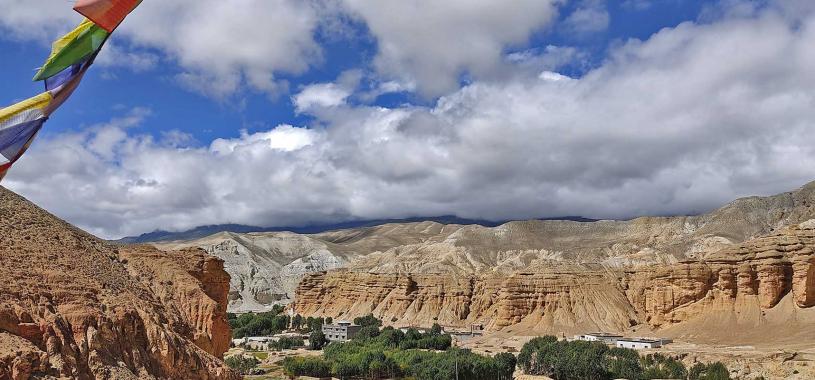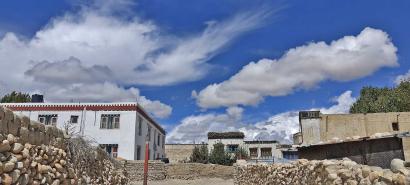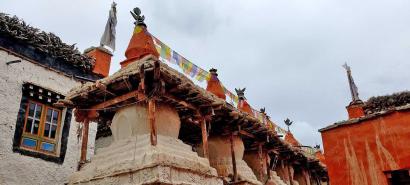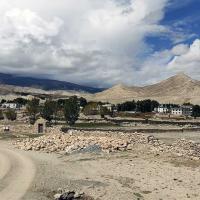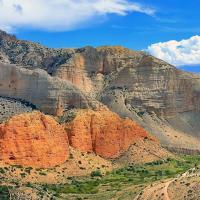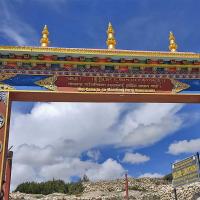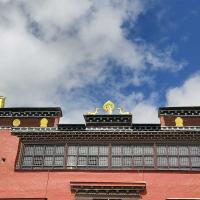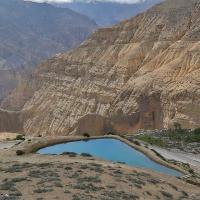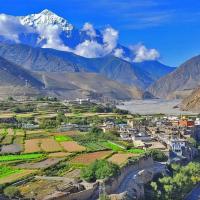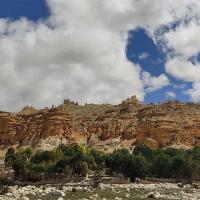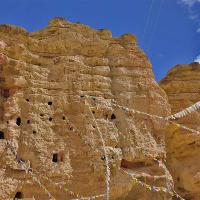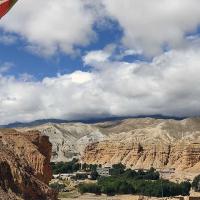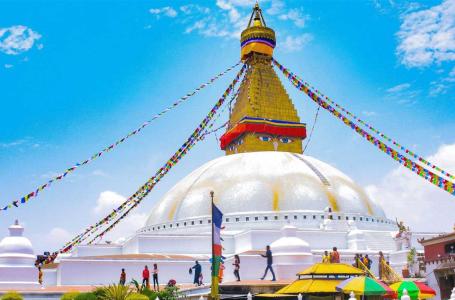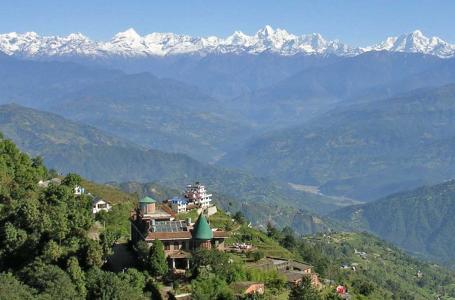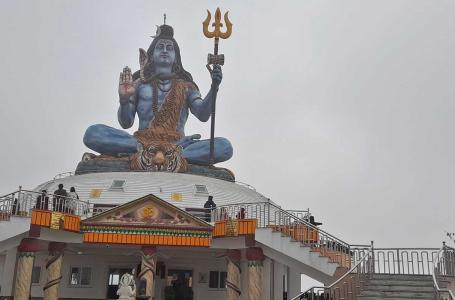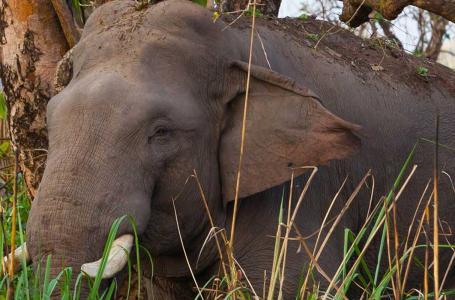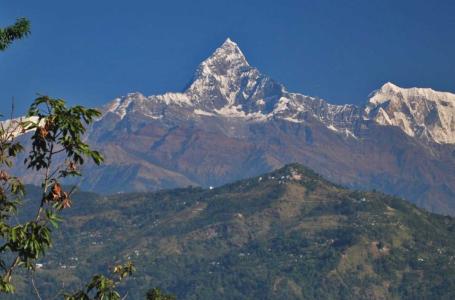- 02 Pax USD 1750 pp
- 03 to 05 Pax USD 1650 pp
- 06 to 10 Pax USD 1550 pp
- 11 to 15 Pax USD 1475 pp
Itinerary
Arrive in Kathmandu, the vibrant capital of Nepal. Check into your hotel and take the day to relax and acclimate to the new environment. Explore Thamel, a bustling district known for its shops and restaurants.
Spend the day visiting Kathmandu's major attractions. Explore the UNESCO World Heritage Sites such as Swayambhunath Stupa (Monkey Temple), Boudhanath Stupa, and Pashupatinath Temple. Prepare for your Upper Mustang adventure by finalizing permits and packing essentials.
Take a scenic flight to Pokhara, a picturesque city renowned for its stunning mountain views and serene lakes. Enjoy a leisurely stroll around Phewa Lake and visit the nearby Tal Barahi Temple.
Fly from Pokhara to Jomsom, the gateway to Upper Mustang. Begin your trek to Kagbeni, a charming village known for its traditional architecture and Buddhist monasteries. Overnight stay in Kagbeni.
Embark on a trek from Kagbeni to Chele. Pass through beautiful landscapes, ancient caves, and traditional villages. Chele offers a glimpse into the unique culture of the Mustang region.
Continue your trek from Chele to Syangboche. Traverse through high-altitude deserts and barren lands, experiencing the rugged beauty of the Mustang region. Enjoy the serene environment and acclimatize to the altitude.
Today’s trek will take you from Syangboche to Ghami, a larger village surrounded by stunning scenery. Ghami is known for its ancient monasteries and traditional Mustang culture. Explore the village and soak in the views.
Trek from Ghami to Tsarang, another significant village in Upper Mustang. Tsarang is famous for its impressive monastery and ancient fort. Explore the historical sites and experience local life.
Travel from Tsarang to Lo Manthang, the capital of Upper Mustang. Lo Manthang is a walled city with rich Tibetan-influenced culture and historic monasteries. Visit the King’s Palace and explore the city’s unique architecture.
Spend a day exploring Lo Manthang. Visit key sites including the Thubchen Monastery, Chhoser Cave, and various local temples. Take the opportunity to interact with the locals and learn about their customs and traditions.
Begin your return trek to Dhakmar. The route offers different perspectives of the Mustang landscape, allowing you to appreciate the diversity of the region. Overnight stay in Dhakmar.
Trek from Dhakmar back to Kagbeni. Enjoy the journey through familiar trails and relish the final moments in the Mustang region. Spend the night in Kagbeni.
Fly from Jomsom back to Pokhara. Relax and reflect on your trekking experience. Enjoy some leisure time in Pokhara, exploring its natural beauty and enjoying local cuisine.
Return to Kathmandu by flight. Take this day to do any last-minute shopping, relax, or visit additional sites in the city. Prepare for your departure the following day.
Depart from Kathmandu and head to the airport for your onward journey or flight home.
Overview
Upper Mustang, often referred to as the "Last Forbidden Kingdom," is a remote and mysterious region in the Annapurna area of Nepal. This extraordinary landscape has remained largely untouched by modern development, preserving its ancient Tibetan culture, breathtaking terrain, and time-honored traditions. Trekking through Upper Mustang offers a rare glimpse into a lifestyle that has persisted for centuries, allowing adventurers to immerse themselves in Nepalese heritage while experiencing some of the world's most dramatic scenery. This trek is perfect for travelers seeking an off-the-beaten-path experience, offering both adventure and cultural immersion.
Starting Point: Jomsom – The Gateway to Upper Mustang
The journey begins in Jomsom, a small yet significant town that serves as the gateway to Upper Mustang. From here, trekkers embark on an awe-inspiring adventure through Mustang Valley, a region known for its striking landscapes and unique cultural experiences. The well-designed trail accommodates various trekking skill levels, making it an ideal route for both seasoned hikers and beginners. As you ascend further into the heart of Upper Mustang, the scenery transforms from lush green landscapes to an arid, almost extraterrestrial terrain dominated by towering cliffs, deep gorges, and colorful rock formations.
Along the way, trekkers will pass through picturesque villages like Kagbeni, Chele, Syangbochen, and Tsarang before reaching Lo Manthang, the walled capital of Upper Mustang. Each village offers unique cultural encounters, including traditional mud-brick homes, ancient Buddhist monasteries, and vibrant prayer flags fluttering against the vast Himalayan backdrop.
Restricted Area Permit and Regulations
Upper Mustang remains a restricted region, so trekkers must obtain a Restricted Area Permit (RAP) from the Nepal Immigration Office. As of November 2025, the government has abolished the old flat-rate of US$ 500 for 10 days; now, the permit costs US$ 50 per person per day, and there is no minimum stay.
Despite this more flexible pricing, certain permit requirements remain unchanged: trekkers must travel with a licensed guide, and solo trekking is still not allowed — you need to be part of a group (minimum two people).
Additionally, trekkers are required to have an Annapurna Conservation Area Permit (ACAP), which costs NPR 3,000 (around US$ 25) per person.
Unique Cultural and Spiritual Experiences
One of the highlights of the Upper Mustang Trek is the opportunity to visit ancient monasteries that have been heavily influenced by Tibetan culture. The region is home to numerous gompas, many of which are centuries old and continue to serve as important centers for religious practice and community gatherings. These monasteries, adorned with intricate wood carvings, antique manuscripts, and stunning thangkas (Buddhist paintings), offer valuable insights into the spiritual life of the Mustang people.
Exploring these sacred sites fosters a deeper connection to the region's spiritual and cultural roots. The majority of the inhabitants in Upper Mustang are of Tibetan descent, and their daily lives are deeply intertwined with Buddhist traditions. As you traverse through remote villages, you will have the chance to interact with the locals, who are known for their warmth and hospitality. Their unique customs, vibrant festivals, and traditional culinary practices provide a rare and immersive experience, giving visitors a true taste of Mustang’s preserved way of life.
One of the most significant festivals in Upper Mustang is the Tiji Festival, a three-day celebration held in Lo Manthang. This sacred event features masked dances, ritual performances, and Buddhist ceremonies that symbolize the triumph of good over evil. Attending the Tiji Festival is a once-in-a-lifetime experience that allows trekkers to witness Mustang’s rich spiritual heritage firsthand.
A Remote and Tranquil Trekking Experience
What sets the Upper Mustang Trek apart is the sense of solitude and adventure it provides. Unlike the more crowded trekking routes of Everest or Annapurna, Upper Mustang remains relatively less explored, offering a peaceful and intimate trekking experience. The serene environment, combined with breathtaking views and cultural richness, creates an ambiance that is both humbling and exhilarating. The trek presents moderate to challenging terrain, high-altitude passes, and variable weather conditions, requiring good physical fitness and preparation. However, the rewards are immense—stunning vistas, fascinating cultural encounters, and the chance to walk in the footsteps of ancient traders and nomads.
Trekking in this region also provides stunning panoramic views of Dhaulagiri (8,167m), Annapurna (8,091m), Nilgiri, and other snow-capped peaks, adding to the awe-inspiring experience. The arid landscapes, deep canyons, and unique rock formations further enhance the region’s unparalleled beauty.
Essential Preparation for the Upper Mustang Trek
Proper preparation is crucial for a successful trek in the Upper Mustang. Due to its high-altitude setting, it is advisable to spend a few days acclimatizing in Jomsom or other nearby locations before beginning the trek. Hiring a knowledgeable guide and support staff enhances the journey by ensuring safety and providing deeper insights into the region’s history and traditions. Packing the right gear is also essential—warm clothing, durable hiking boots, a quality sleeping bag, and other necessary trekking essentials will help you navigate the challenging yet rewarding trails.
Trekking in Upper Mustang is best undertaken during spring (March to May) and autumn (September to November) when the weather is stable, and visibility is at its best. Winters can be extremely cold, with snowfall making some trails difficult to navigate, while the monsoon season (June to August) brings strong winds and occasional rainfall.
An Unforgettable Trekking Adventure
The Upper Mustang Trek is much more than just a physical challenge—it is a journey through a unique and culturally rich region that offers an unparalleled travel experience. From its breathtaking landscapes to its deep-rooted traditions, this trek allows adventurers to witness the true essence of Nepal. Whether you are an experienced hiker looking for a new challenge or a traveler seeking an off-the-beaten-path experience, Upper Mustang promises an adventure that will stay with you long after you return home.
Moreover, for those looking for a Bike Tour Adventure, we also offer Upper Mustang Bike Tour. Likewise, for the admirers of Horse Riding Adventure, Upper Mustang Horse Riding Trek is also available at Trek Mania Nepal.
Highlights
- Experience the roots of Lo Manthang.
- Explore several Gompas, chortens, fluttering prayer flags, and tunnels.
- Get a firsthand look at Tibetan influence and local culture.
- Views of the Nilgiri, Annapurna, Dhaulagiri, and other mountain ranges.
- Breathe in the spirituality of Tibetans and monks with their prayer flags.
- Witness the daily lives and cultures of the locals who live in close quarters, such as Tibetans.
Cost Details
- Airport pickup and drop service.
- Accommodation in Kathmandu 2 nights.
- All food during the trek (B, L, D included).
- Accommodation during the jeep Tour.
- Transportation (depending upon the price and group size).
- Government license holder English speaking trekking guide and His salary, lodging, food, and insurance.
- Permits: Upper Mustang Special Permit (Ten days only).
- Annapurna Conservation Permit.
- First aid medical box.
- T-shirt, Duffel Bag, and Trekking Map with company logo.
- Rescue Management Service.
- All Tax (13% Vat and 10% Service charge)
- Farewell Dinner.
- All kinds of Drinks.
- Foods in Kathmandu.
- Visa fee to enter Nepal.
- International flight tickets.
- Extra night accommodation and meal costs in Kathmandu due to any change in the scheduled itinerary.
- All required trekking gear like sleeping bags and down jackets made available on rent.
- Travel insurance/ Rescue operation costs.
- All personal expenses.
- Tip for guides and porters
Dates & Pricing
Trip Start and End Point
Kathmandu / Kathmandu
| DATES | STATUS | PRICE | SPACE LEFT | ||||
|---|---|---|---|---|---|---|---|
|
Start date: 10-Feb, 2026
End date: 24-Feb, 2026 |
Guaranteed | USD 1750 |
5
|
Book Now | |||
|
Start date: 25-Feb, 2026
End date: 11-Mar, 2026 |
Guaranteed | USD 1750 |
5
|
Book Now | |||
|
Start date: 05-Mar, 2026
End date: 19-Mar, 2026 |
Guaranteed | USD 1750 |
2
|
Book Now | |||
|
Start date: 12-Mar, 2026
End date: 26-Mar, 2026 |
Guaranteed | USD 1750 |
1
|
Book Now | |||
|
Start date: 01-Apr, 2026
End date: 15-Apr, 2026 |
Guaranteed | USD 1750 |
1
|
Book Now | |||
|
Start date: 25-Apr, 2026
End date: 09-May, 2026 |
Guaranteed | USD 1750 |
1
|
Book Now | |||
|
Start date: 07-May, 2026
End date: 21-May, 2026 |
Guaranteed | USD 1750 |
1
|
Book Now | |||
|
Start date: 11-May, 2026
End date: 25-May, 2026 |
Guaranteed | USD 1750 |
1
|
Book Now | |||
|
Start date: 12-May, 2026
End date: 26-May, 2026 |
Guaranteed | USD 1750 |
2
|
Book Now | |||
|
Start date: 13-May, 2026
End date: 27-May, 2026 |
Guaranteed | USD 1750 |
4
|
Book Now | |||
|
Start date: 02-Jun, 2026
End date: 16-Jun, 2026 |
Guaranteed | USD 1750 |
2
|
Book Now | |||
|
Start date: 15-Jul, 2026
End date: 29-Jul, 2026 |
Guaranteed | USD 1750 |
2
|
Book Now | |||
|
Start date: 15-Jul, 2026
End date: 29-Jul, 2026 |
Guaranteed | USD 1750 |
2
|
Book Now | |||
|
Start date: 19-Aug, 2026
End date: 02-Sep, 2026 |
Guaranteed | USD 1750 |
3
|
Book Now | |||
|
Start date: 05-Sep, 2026
End date: 19-Sep, 2026 |
Guaranteed | USD 1750 |
2
|
Book Now | |||
|
Start date: 26-Sep, 2026
End date: 10-Oct, 2026 |
Guaranteed | USD 1750 |
3
|
Book Now | |||
|
Start date: 05-Oct, 2026
End date: 19-Oct, 2026 |
Guaranteed | USD 1750 |
2
|
Book Now | |||
|
Start date: 25-Oct, 2026
End date: 08-Nov, 2026 |
Guaranteed | USD 1750 |
2
|
Book Now | |||
|
Start date: 15-Nov, 2026
End date: 29-Nov, 2026 |
Guaranteed | USD 1750 |
2
|
Book Now | |||
|
Start date: 21-Nov, 2026
End date: 05-Dec, 2026 |
Guaranteed | USD 1750 |
2
|
Book Now | |||
Equipment List
- Woolen shirts and thick sweaters.
- Jackets (Fiber or down).
- Waterproof jacket with hood or poncho.
- Tracksuit, Track shoes and Trousers.
- Thermal Underwear and Thermal Coat.
- 2pair of loose-fitting long shorts/ skirts.
- Pair of Gloves and sandals.
- Woolen hat and long-sleeved shirt.
- Light weight walking boots.
- 2 pairs of thin socks and 2 pair of woolen socks.
- Snow glasses and sunglasses.
- Trekking Sticks and Duffle bag or kit bag to carry to gear while trekking.
- Some (small/large) plastic bags to separate clean clothes from dirty ones and some smaller plastic bags to dispose of garbage.
- Daypack bag to carry your requirements.
- Water Bottle, water purifying tablets.
- Towels, Umbrella (optional).
- Headlamp, Binocular, Camera, trekking map and compass, reading materials, pencil, rubber, pen, notebook, and moisturizer for lip, face body
FAQs
The Upper Mustang Trek is a restricted region trek that offers a rare glimpse into the ancient Tibetan Buddhist culture, dramatic desert landscapes, and medieval walled city of Lo Manthang.
Upper Mustang features a barren, high-altitude desert, with colorful eroded cliffs, deep canyons, ancient caves, and the stunning Kali Gandaki Gorge, set against the backdrop of Annapurna and Dhaulagiri ranges.
The region was once part of the ancient Tibetan kingdom, and it retains a unique Tibetan-influenced culture, with centuries-old monasteries, traditional whitewashed villages, and annual festivals like Tiji.
Despite being one of Nepal’s most remote regions, Upper Mustang has well-established trails and teahouses, but it remains less commercialized and less crowded than other trekking routes.
Unlike most Himalayan treks, Upper Mustang lies in the rain-shadow of the Annapurna range, meaning it is one of the few treks in Nepal that can be done even during the monsoon season (June–August).


